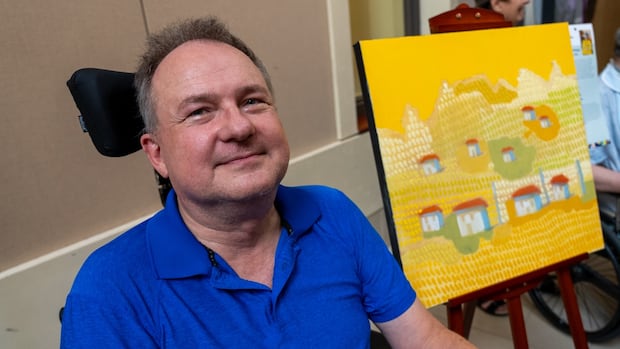'Hallway of sadness' transformed by patients' art at Ottawa hospital
Coffee grounds, conversation and memories turned into art — and legacy
Tucked between patient rooms on the 5 North unit at Ottawa's Bruyère Health Saint-Vincent Hospital, a quiet hallway serves as a daily passage for staff and visitors alike.
But the corridor once referred to as "the hallway of sadness" is about to take on a new identity.
With Hallways of Hope, a new initiative led by Bruyère chaplain Roshene Lawson, long-term care patients of a ventilation unit have been invited to turn the once "gloomy" corridor into a vibrant gallery of their own making.
After several months of work, a temporary exhibit held at the hospital last week offered a preview.
Each piece is different, shaped by its own inspiration and technique. Some are deeply personal: a dog named Casey, a memory of Spain and even a forest rendered in thumbprints and coffee grounds.
Created with the help of Ottawa artist Christopher Griffin, the works reflect each patient's ability — and willingness — to try. Some held pencils in their mouths. Others used their hands. Most had never painted before.

A comment that sparked a movement
The idea began with a moment of honesty.
"Back in November, we were dealing with a realization of how dark things can be on our unit," said Dr. Chris Kirby, a physician on 5 North. "The burden of illness that our patients were shouldering … affects everybody — them, but also their caregivers."
During rounds, Kirby made a passing remark about the atmosphere on the unit. "I kind of made this backhanded comment about how it was the hallway of sadness," he recalled.
Lawson, the chaplain, heard the comment and invited Kirby to discuss it. "I was kind of like a teacher after class saying, 'You need to stay after and talk to me,'" she recalled. "I could tell he was struggling with the burden of what his patients were carrying."

Many patients on the unit live with ALS, also known as Lou Gehrig's disease, or other degenerative neuromuscular conditions. Some have lost speech, others mobility. Most face slow, progressive decline — and a hospital setting that can feel "very grey," as Kirby put it.
"You're here for a long time. These are days that blend into each other," he said.
For Lawson, the unit's role isn't just clinical — it's about human relationships.
"Five North is not necessarily about a cure," she said. "It's about accompaniment — how we accompany our patients and families and each other on this unit. The journeys can be dark and a burden, but there can also be joy in darkness."
Inspired, Kirby reframed his thoughts of the corridor. "You can't be focused on the negative," he said. "So I spun it and said, 'OK — hallway of hope.'"
Lawson picked up the phone and called local muralist Griffin with a pitch: "There's no money in it," she warned him. "But there's great joy and purpose in it — and great meaning."
Griffin immediately said yes.

Where memories meet the canvas
Each painting on display in the 5 North exhibit carries more than colour and texture — it carries a story.
For Badrudduza Kazi, whose ALS has left him unable to hold a brush, the medium became as important as the message. Using coffee grounds and his thumb, he created Golden Quiet, a warm, pastoral landscape dotted with trees and sunlight.
"It's a hope of life," he said softly, looking over the canvas. Kazi, who's unable to move his hands or fingers, credits Griffin with helping him believe he could still create. And he did.

Griffin helped adapt each technique to the abilities of each patient.
"I would dip their fingers into coffee grounds, and we'd basically finger paint," he said. "We had to rotate the canvas as we worked, because of their mobility — they could only reach so far. So we ended up painting landscapes sideways and even upside down."
Kim Otte, another patient and contributor, was inspired by the memory of southern Spain. His painting, Malaga Sun, channels the warmth and calm he remembers from his time living in Europe.
"I was asked to pick a place that was perhaps the most positive experience," he said. "This is the part of Malaga in southern Spain … it's a very serene place, beautiful climate. I have many, many happy memories from that place."
Otte also appreciated the fact that the paintings will be on permanent display. "Because obviously at some point I'm not going to be here … you put a little fingerprint on the place," he said.

Another participant, Martin Meech, painted a scene based on his childhood memories at a lake near Lac Long in Quebec. His work, Where the Trees Remember, is rich with coffee-textured trees and orange foliage.
"At the end, I couldn't believe it," Meech said. "It was just wonderful."
The painting helps him return to a time he still holds dear. "It reminds me of everything — especially our cottage," he said. "The trails, the nature — everything."
Meech said he hopes others take away the same sense of optimism that the project brought him.
"If people stay positive, they do a lot better," he said. "And hope brings them positivity."
The exhibit has drawn praise from families, staff and even patients who once said they'd never hold a brush. But for those involved, the real transformation happened well before the first canvas was hung — in the quiet moments of creation, conversation and care.
"Hope doesn't mean a cure," said Lawson. "Hope means they get treated with dignity and love and respect and kindness."

